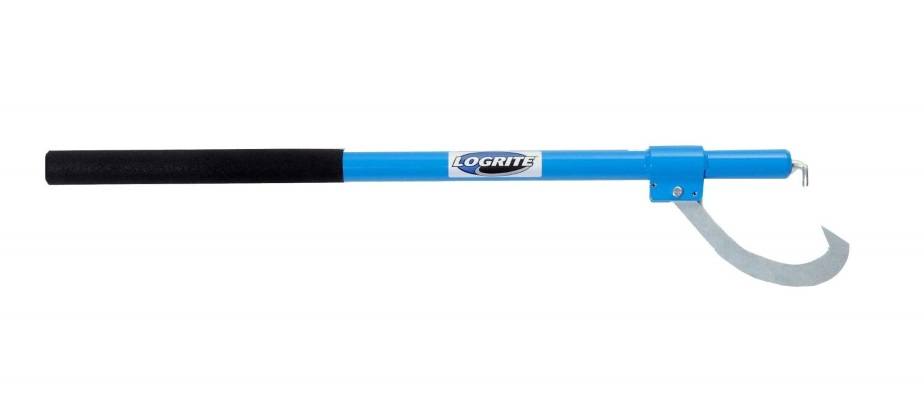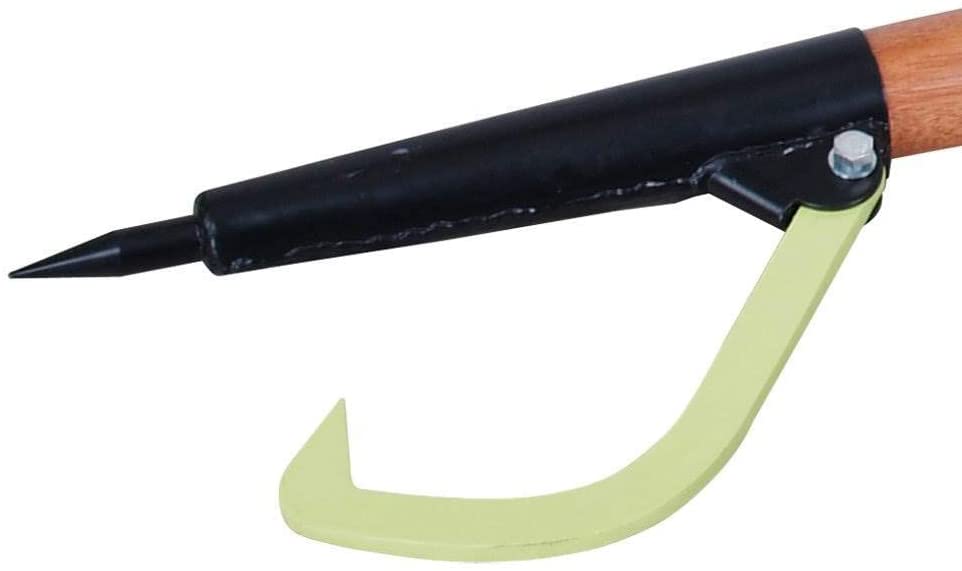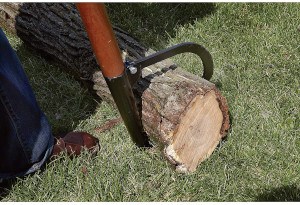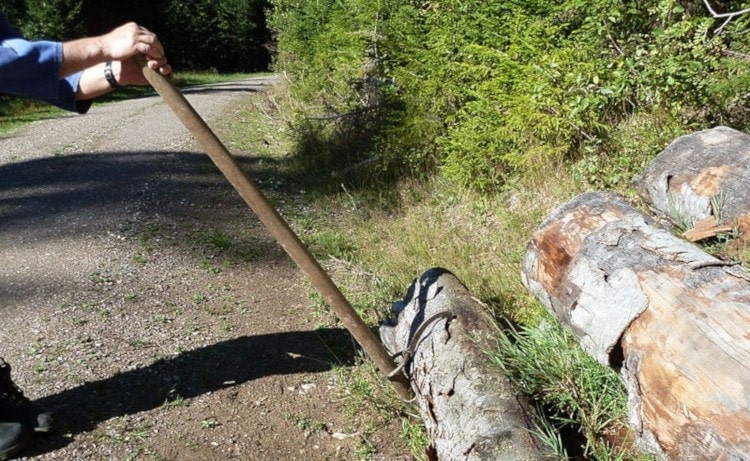Cant Hook vs Peavey: What’s the Difference?
-
- Last updated:


Nothing is worse than when you have two seemingly identical options in front of you. Without any significant discrepancies between the two things, it can seem impossible to know which one to select. This is the dilemma between choosing a cant hook or a peavey.
Cant hooks and peaveys are two tools that perform the same job with very little difference between them. To someone who is just getting started in logging, it can be challenging to know which one is better.
In short, both tools perform the same function, and their only difference is how they grip the wood. Neither is more efficient than the other. The decision between a cant hook and a peavey comes down to one thing: personal preference.
Before deciding on a hook, you might want to know a little more about both. Here, we provide you with an overview and comparison of the cant hook and the peavey. Let’s dig right in.

Overview of Cant Hooks

A cant hook moves, lifts, and pivots logs around. Since they are used at a sawmill or woodlot, they are considered a woodworker’s tool. They simply make hauling the log easier since you don’t have to lug it around yourself.
The hook consists of a wood lever handle, pivoting metal hook (the “dog”), and a flat-ended gripper foot. The hook at the end acts as a second biting edge, which allows the hook to get a better grip on the log. Though the hook is smaller than the one on the peavey, it is less suitable for larger logs. It gets a good grip, nonetheless.
Best For
Since cant hooks have strong gripping power, they are great for moving logs at a sawmill. The grip is smaller than the peavey’s grip, which means it can only hold smaller logs, in any case. With this in mind, the cant hook is best for when you need strong gripping power.
Benefits
Since the cant hook has two biting edges, it gets a better grip on the log. Though this might not sound like a major benefit, it certainly helps a ton when a log is slippery or difficult. It alleviates the time trying to get the log and ensures that it stays on the hook.
Due to the general use of the cant hook, it is extremely versatile. It is specific enough that it provides a specialized function within the woodworking community. Still, it is versatile enough to use it in different scenarios, making it one of the most popular tools.
Another benefit of the cant hook is that it is safer than the peavey. The peavey has a sharp point at the end of the handle, while the cant hook has a flat edge. This flat edge minimizes the chances of getting cut or stabbed when working with the tool.
Drawbacks
Since cant hooks have smaller hooks, they are not suitable for moving large or extra-large logs. They simply will not be able to grip around the logs enough so that you can transport them safely.
Another drawback of the cant hook is that working in log piles will be tight. This can be incredibly cumbersome, time draining, and exhausting.
Takeaway
Cant hooks are a useful tool for moving small to medium-sized logs. The double edges provide amazing gripping power that is very one of a kind. Those looking for a safe and efficient hook will find the cant hook especially helpful for moving logs.
- Highly efficient gripping powers
- Versatile
- Safe
- Not suitable for large or extra-large logs
- Working in log piles will be tight

Overview of a Peavey
A peavey is similar to a cant hook, but it has some notable differences. The design of the peavey includes a pivoting metal hook and a wooden lever handle. However, whereas the cant hook has a gripper foot, the peavey has a protruding spike. This spike is what separates a peavey from a cant hook.
The spike on the peavey is useful for separating logs, such as logs in a big pile. As a result, the peavey separates and moves logs. These tools often lift, move, and pivot logs by woodlots, sawmills, and rivers alike.
Since the peavey does not have double edges like the cant hook, the peavey’s gripping hook usually is larger than the hook found on the cant. This makes the peavey more suited for picking up large and extra-large logs, as well as small and medium-sized logs.

Best For
Given the spike and hook design, a peavey is useful for when you need to pivot, separate, and move larger logs. If you find a large piece of wood, you can separate it using the spike. Then, you know that the large hook will fit around most logs due to its larger size.
Benefits
The biggest benefit of the peavey is its large hook. Because of this hook, the peavey can grip larger logs, something that the cant hook cannot do. As a result, you will be able to move more logs with this tool.
Due to both the hook and the spike, the peavey is also highly functional. Just like the cant hook, it can be used in any woodworking environment, and it will get good usage. The peavey is by far one of the most versatile and inexpensive tools you can get for woodworking.
Drawbacks
Though the spike is useful, it also makes the peavey have some drawbacks. Most notably, it prevents the tool from having double gripping edges. This then causes the peavey as a whole to have worse gripping power than the cant hook. It simply does not grip very well.
Additionally, the spike can be very dangerous. If someone falls on the spikey end, they will easily injure themselves. Depending on where the spike lands will determine the severity of the injury. Always handle the peavey with care and caution for this reason.
Final Takeaway
A peavey is a great option if you need to separate and move large logs. The spite makes separating easier, while the large hook can fit around most logs. Just make sure to be careful when using this tool since the spike is very sharp and dangerous.
- Handles larger wood
- Separates wood easily
- Versatile
- Does not grip well
- Dangerous
A Quick Comparison of Cant Hook vs Peavey
| Cant Hook | Peavey | |
| Best for | Superior gripping
Safety features |
Gripping larger logs
Splitting wood |
| Pros | Better grip
Safer Versatile |
Can grip larger logs
Separates wood easily Versatile |
| Cons | Cannot grip larger logs
Working in log piles will be tight |
Poor gripping abilities
Dangerous |
| Design at the End of the Handle | Gripper foot with a flat end | Protruding spike |
| Number of Edges | 2 | 1 |
How They Hook
The biggest difference between the cant hook and peavey is how they hook. Since they have different designs at the ends of their handles, they hook differently.
The cant hook includes a gripper foot and pivoting metal hook. These two hooks provide a double edge for the hook. As a result, the cant hook grips the log from both sides, allowing it to grip more securely.

The peavey, on the other hand, includes a spike and a pivoting metal hook. The spike is useless for gripping logs, meaning that the pivoting metal hook does all the gripping work. This explains why the peavey hook does not have as good of gripping powers as the cant hook.
Considering these things, you should get the cant hook if you want a hook with maximum protection from both sides. This will help keep the logs in place, even if they are slippery or wet.

Hook Size
Hook size is another big difference between a cant hook and a peavey. Peaveys tend to have larger hooks than cant hooks. This allows them to handle larger logs that a cant hook simply would not be able to pick up.
If you need a hook for larger logs, then you should get the peavey for sure. Though the cant hook is excellent for small or average-sized logs, it cannot grip the larger logs that might be found around a sawmill or river area.
Safety Features
As a woodworker, you are probably used to handling dangerous tools. Still, you should consider all tools’ safety features, not just those that offer more serious injuries.
The peavey is by far more dangerous than the cant hook. When handling a peavey, you run the risk of stabbing yourself with or falling on the spike. Since you may be working in slippery or messy conditions, it is not unimaginable that you could lose your balance and fall on the spike.
If safety is an important feature to you (which it should be), the cant hook is safer. Since the gripper foot has a flat edge, you have much less chance of getting injured while using the cant hook than the peavey.
Quick Look: Our Top Choices
| LogOX Hauler | Timber Tuff Peavey | |
| Griping Diameter | 21″ | 12″ |
| Double Edges? | Yes | No |
| Weight | 6.2 lbs. | 8 lbs. |
| Warranty? | Yes | No |
| Cost | $$ | $ |
Our Favorite Cant Hook: LogOX Hauler

The LogOX Hauler is easily one of the most impressive cant hooks. It has near-perfect reviews on all shopping websites, reflecting its durability, grip-ability, and overall power as a cant hook. This cant hook comes with a hook tip and a 21-inch hook that is big enough for even large logs, making it a great option for those who need high gripping power for many log sizes. The LogOX is made from durable materials, and the company even offers a 100% Ironclad Lifetime Manufacturer’s Warranty. This warranty tells you that the manufacturers put money on your satisfaction.
Our Favorite Peavey: Timber Tuff 4 inch Long Peavey

The Timber Tuff 4 inch Long Peavey is a durable, classic, and powerful peavey. It is 48 inches long, and it handles logs of up to 12 inches in diameter. This model is great for moving large logs. The materials used on this product are durable and resistant. They are treated with a powder coat finish that resists corrosion, ensuring that the peavey lasts a long time. This is a remarkable fact, especially considering how affordable the peavey is.
- See Also: 7 Best Cant Hooks & Peavey

Conclusion
Lifting logs can be difficult, especially if you do it all day. Cant hooks and peavies are two tools you can use to make the process a little bit easier. You can use the cant hook for smaller, more slippery logs while using the peavey for larger logs that may need splitting.
Either way, both tools offer about the same benefits. To decide on a model, think about your preferences and the type of wood you intend to be moving. Between the two factors, preference is actually more important.
If you just think about what matters the most to you, you will be pleased with whichever you choose since they both are super helpful and efficient. Just go with your gut, and the rest should work itself out.
Related Reads:
- SPOKESHAVE VS DRAWKNIFE: WHAT’S THE DIFFERENCE?
- GAS VS. ELECTRIC HEDGE TRIMMERS: WHICH ONE TO CHOOSE?
- POWER RAKE VS. DETHATCHER: WHAT’S THE DIFFERENCE?
Contents

